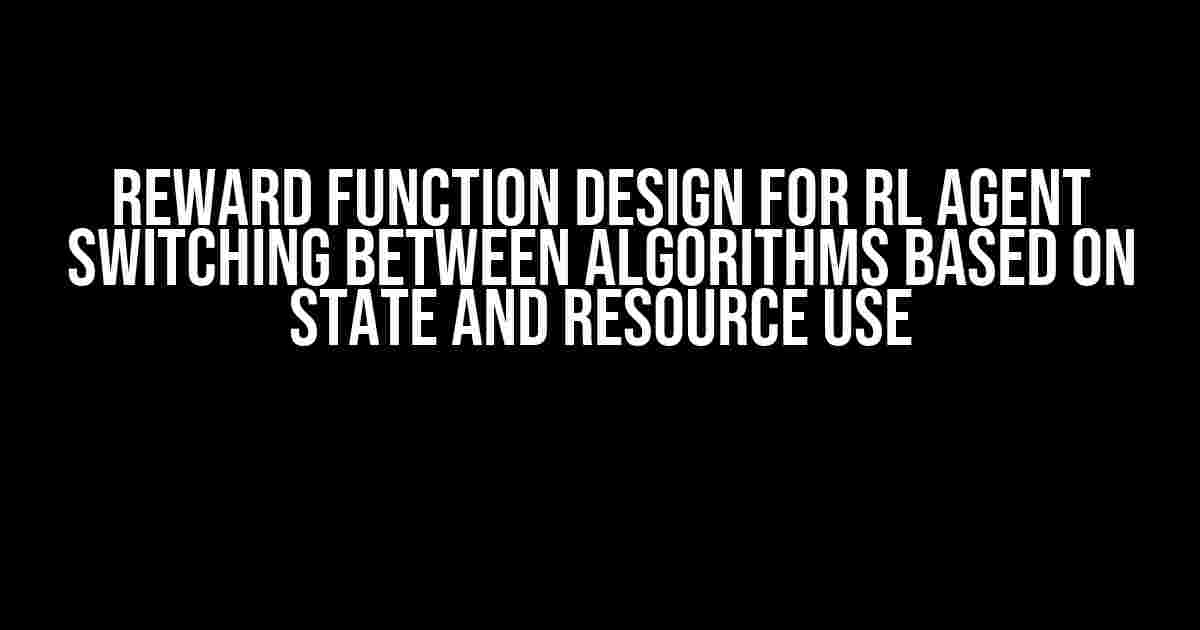Welcome to the world of Reinforcement Learning (RL), where agents learn to make decisions by interacting with their environment and receiving rewards or penalties. One of the most significant challenges in RL is designing an effective reward function that encourages the agent to behave in a desired manner. In this article, we’ll dive into the world of reward function design, specifically focusing on creating a reward function that enables an RL agent to switch between algorithms based on state and resource use.
Why Do We Need a Reward Function?
In RL, the reward function is the heart of the learning process. It’s responsible for evaluating the agent’s performance and providing feedback in the form of rewards or penalties. The goal is to maximize the cumulative reward over time, which motivates the agent to learn and adapt. A well-designed reward function can make all the difference between an agent that learns quickly and efficiently versus one that gets stuck in local optima.
The Challenges of Reward Function Design
Designing an effective reward function is a daunting task, especially when dealing with complex environments and multiple algorithms. Some common challenges include:
- Exploration-Exploitation Trade-off: Balancing exploration of new actions and exploitation of known actions to maximize rewards.
- Curse of Dimensionality: Handling high-dimensional state and action spaces that lead to an exponential increase in complexity.
- Misaligned Objectives: Ensuring the reward function aligns with the desired behavior and objectives.
- Overfitting: Avoiding overfitting to specific scenarios or states, which can lead to poor generalization.
Reward Function Design for RL Agent Switching
Now, let’s focus on designing a reward function that enables an RL agent to switch between algorithms based on state and resource use. We’ll use a combination of techniques to create a robust and adaptive reward function.
State-Based Reward Function
One approach is to design a state-based reward function that evaluates the agent’s performance based on its current state. This can be achieved using a weighted sum of rewards, where each reward corresponds to a specific state feature:
R(s) = w1 \* r1(s) + w2 \* r2(s) + … + wn \* rn(s)
where:
- R(s) is the total reward for state s
- wi are the weights for each reward component
- ri(s) are the individual rewards for each state feature
Resource-Based Reward Function
An alternative approach is to design a resource-based reward function that takes into account the agent’s resource utilization. This can be achieved using a resource-based reward function:
R(a) = r_cpu(a) + r_mem(a) + … + r_power(a)
where:
- R(a) is the total reward for action a
- r_cpu(a), r_mem(a), …, r_power(a) are the individual rewards for each resource type
Hybrid Reward Function
A more comprehensive approach is to combine both state-based and resource-based rewards into a hybrid reward function:
R(s, a) = w_state \* R(s) + w_resource \* R(a)
where:
- R(s, a) is the total reward for state s and action a
- w_state and w_resource are the weights for state-based and resource-based rewards
Switching Between Algorithms
Now that we have a hybrid reward function, let’s discuss how to use it to switch between algorithms based on state and resource use. We’ll use a simple threshold-based approach:
- Define a set of algorithms A = {a1, a2, …, an}
- Define a set of states S = {s1, s2, …, sm}
- Define a set of resource thresholds T = {t_cpu, t_mem, …, t_power}
- For each state s in S:
- Evaluate the hybrid reward function R(s, a) for each algorithm a in A
- Compare the rewards to the resource thresholds T
- Switch to the algorithm with the highest reward that satisfies the resource constraints
Example Implementation
Let’s illustrate this concept with a simple example in Python using the Gym environment and the Q-learning algorithm:
import gym
import numpy as np
# Define the environment
env = gym.make('CartPole-v1')
# Define the algorithms
algorithms = ['Q-learning', 'SARSA', 'DQN']
# Define the states
states = ['state1', 'state2', 'state3']
# Define the resource thresholds
thresholds = {'cpu': 0.5, 'mem': 0.8, 'power': 0.3}
# Define the hybrid reward function
def hybrid_reward(state, action):
# State-based reward
state_reward = np.random.rand()
# Resource-based reward
resource_reward = np.random.rand()
# Hybrid reward
return 0.5 \* state_reward + 0.5 \* resource_reward
# Define the algorithm switching logic
def switch_algorithm(state, action):
rewards = []
for algorithm in algorithms:
reward = hybrid_reward(state, action)
if reward > thresholds['cpu'] and reward > thresholds['mem'] and reward > thresholds['power']:
rewards.append(reward)
else:
rewards.append(-reward)
# Switch to the algorithm with the highest reward
return algorithms[np.argmax(rewards)]
# Run the environment
for episode in range(10):
state = env.reset()
done = False
rewards = 0
while not done:
action = switch_algorithm(state, None)
state, reward, done, _ = env.step(action)
rewards += reward
print(f'Episode {episode}: {rewards}')
This example demonstrates how to design a hybrid reward function and use it to switch between algorithms based on state and resource use. Note that this is a simplified example, and you may need to modify and extend it to suit your specific use case.
Conclusion
Reward function design is a crucial aspect of Reinforcement Learning, and designing an effective reward function can make all the difference in an agent’s performance. By combining state-based and resource-based rewards, we can create a hybrid reward function that enables an RL agent to switch between algorithms based on state and resource use. Remember to carefully evaluate and tune your reward function to ensure it aligns with your desired objectives and environment.
| Reward Function | Description |
|---|---|
| State-Based Reward | Evaluates the agent’s performance based on its current state |
| Resource-Based Reward | Evaluates the agent’s resource utilization |
| Hybrid Reward | Combines state-based and resource-based rewards |
We hope this article has provided you with a comprehensive understanding of reward function design for RL agent switching. Remember to stay tuned for more articles and tutorials on Reinforcement Learning and AI!
Frequently Asked Question
Get ready to dive into the world of Reward Function Design for RL Agents and uncover the secrets of switching between algorithms based on state and resource use!
What is the primary goal of Reward Function Design in RL Agents?
The primary goal of Reward Function Design is to define a reward signal that guides the agent’s learning process, ensuring it takes actions that maximize the cumulative reward and achieve the desired outcome.
Why is it essential to consider state and resource use when designing a Reward Function?
Considering state and resource use is crucial because it allows the agent to adapt to changing environments, allocate resources efficiently, and switch between algorithms effectively, ensuring optimal performance and resource utilization.
How does the Reward Function influence the RL Agent’s decision-making process?
The Reward Function plays a direct role in shaping the agent’s decision-making process by assigning rewards or penalties to its actions, which in turn, influences the agent’s policy and its exploration-exploitation trade-off.
What are some common challenges faced when designing a Reward Function for RL Agents?
Common challenges include defining a reward signal that aligns with the environment’s goals, handling delayed rewards, dealing with high-dimensional state spaces, and avoiding reward hacking and exploitation.
Can you give an example of a real-world application of Reward Function Design in RL Agents?
A classic example is the use of RL Agents in autonomous vehicles, where the Reward Function is designed to optimize fuel efficiency, safety, and passenger comfort while navigating complex traffic scenarios.


